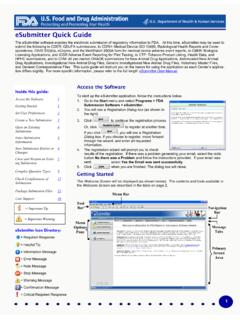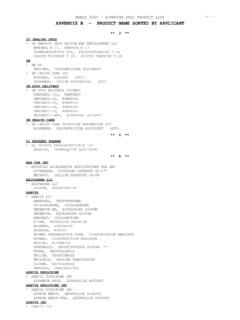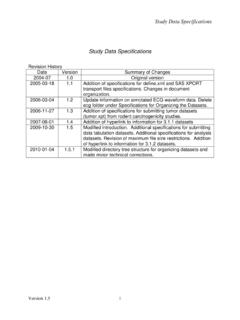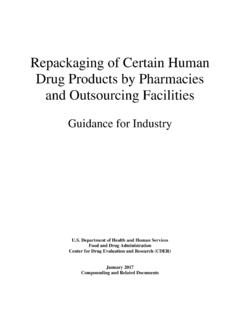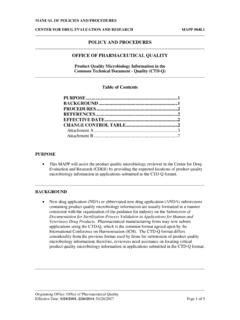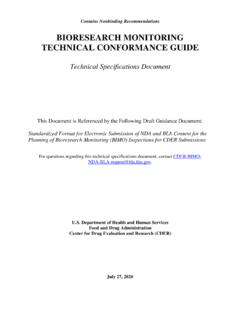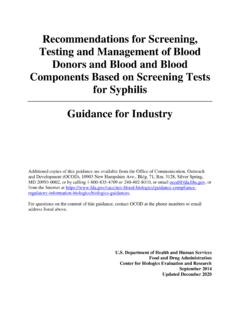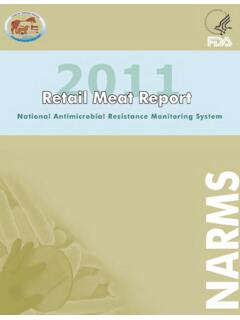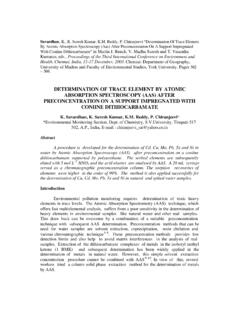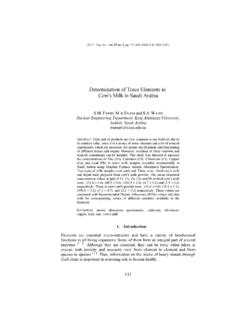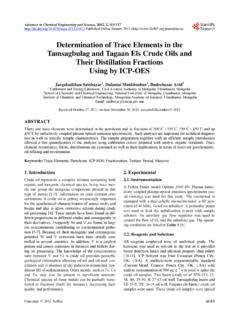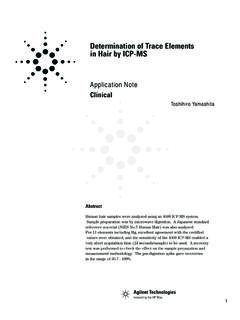Transcription of Elemental Analysis Manual
1 The following is a section of the Elemental Analysis Manual for Food and Related Products. For additional information and to view other sections of the Manual , visit the Elemental Analysis Manual for Food and Related Products web page at Elemental nalysis anual for Food and Related Products Inductively Coupled Plasma-Mass Spectrometric determination of Arsenic, Cadmium, Chromium, Lead, Mercury, and Other elements in Food Using Microwave Assisted Digestion AM Version (February 2020) Current Validation Status: Authors: Patrick J. Gray SINGLE LAB VALIDATION: YES William R. Mindak MULTI-LAB VALIDATION: YES John Cheng GLOSSARY Table of Contents INDUCTIVELY COUPLED PLASMA-MASS SPECTROMETRIC determination OF ARSENIC, CADMIUM, CHROMIUM, LEAD, MERCURY, AND OTHER elements IN FOOD USING MICROWAVE ASSISTED DIGESTION .. 1 SCOPE AND APPLICATION .. 2 SUMMARY OF METHOD.
2 2 EQUIPMENT AND SUPPLIES .. 3 REAGENTS AND STANDARDS .. 5 DIGESTION PROCEDURE .. 9 METHOD QUALITY CONTROL .. 12 determination PROCEDURE .. 15 CALCULATIONS .. 22 REPORT .. 23 METHOD VALIDATION .. 23 METHOD REVISION HISTORY .. 25 REFERENCES .. 25 FDA Elemental Analysis Manual (Section ICP-MS Method) Page 2 of 25 (February 2020) SCOPE AND APPLICATION This method describes procedures for determining total acid-extractable concentrations of arsenic, cadmium, chromium, copper, lead, manganese, mercury, molybdenum, nickel, selenium, thallium and zinc in food by microwave assisted acid decomposition and inductively coupled plasma-mass spectrometry (ICP-MS). Other matrices may be analyzed by these procedures if performance is verified in the matrix of interest, at the concentration levels of interest. This method is not validated for non-food matrices such as mineral dietary supplements or cosmetics.
3 This method should only be used by analysts familiar with trace element Analysis and ICP-MS. The analyst must be trained in the interpretation of spectral and matrix interferences and procedures for their correction. SUMMARY OF METHOD An analytical portion of food is decomposed in acid inside a high-pressure digestion vessel using microwave , 2 The analytical solution is analyzed using an inductively coupled plasma mass spectrometer (ICP-MS). Elemental concentrations are quantified using external calibration and quality controls are incorporated to ensure data quality. Figure 1 shows the method procedures. Figure 1: Procedure flow chart FDA Elemental Analysis Manual (Section ICP-MS Method) Page 3 of 25 (February 2020) Typical analytical limits were calculated per and are listed in Table 1 but will vary depending on the specific instrumentation, dilution factor and blank quality.
4 Significantly lower LODs and LOQs have been achieved for several target analytes for different matrices and larger sample masses. Achieving the lowest limits requires meticulous attention to operating conditions and the highest level of quality control for each set of analyses. Table 1a. Nominal Analytical Limits for Multilab Validated elements Element Symbol MBKL ( g/kg) MBKC ( g/kg) ASDLa ( g/kg) ASQLa ( g/kg) LODb ( g/kg) LOQb ( g/kg) Chromium 52Cr Manganese 55Mn Nickel 60Ni Copper 65Cu Zinc 66Zn 340. Arsenic 75As Selenium 78Se Molybdenum 95Mo Cadmium 111Cd Mercury 201Hg Lead sumPb a. Based upon method blanks measured during the single lab validation over 1 year; n = 143 (see ) b. Based upon g analytical portion and 50 g analytical solution (DF 100x) Table 1b: Nominal Analytical Limits for Single Lab Validated elements Element Symbol MBKL ( g/kg) MBKC ( g/kg) ASDLa ( g/kg) ASQLa ( g/kg) LODb ( g/kg) LOQb ( g/kg) Thallium 205Tl a.
5 Based on a single lab validation (n = 27) (see ) b. Based upon g analytical portion and 50 g analytical solution (DF 100x) EQUIPMENT AND SUPPLIES Disclaimer: The use of trade names in this method constitutes neither endorsement nor recommendation by the U. S. Food and Drug Administration. Equivalent performance may be achievable using apparatus and materials other than those cited here. (1) Inductively coupled plasma mass spectrometer (ICP-MS) Capable of scanning mass-to-charge (m/z) range 5 240 amu with a minimum resolution of amu at 10% peak height. Must have collision/reaction cell that can be pressurized with helium and kinetic energy discrimination for polyatomic interference attenuation. Method was developed FDA Elemental Analysis Manual (Section ICP-MS Method) Page 4 of 25 (February 2020) on Agilent models 7500ce, 7700x, 7900 and 8800 and directions are specific to Agilent brand equipment.
6 Use of the method with other brands of instruments or models may require procedural modifications. Any such modifications must be validated according to FDA guidelines and method quality control elements ( ) must (2) Microwave digestion system Requires temperature control to at least 200 C and pressures 300 psi (~ 20 bar) with appropriate safety features to prevent over-pressurization of vessels. Microwave must have multi-step programming with ramp to temperature capability. Digestion vessels must be PFA, TFM Teflon lined or quartz. Directions on use of microwave digestion equipment are specific to CEM or Milestone . Method was developed using CEM MARS Xpress and Milestone UltraWAVE and UltraCLAVE III systems. (3) Labware All laboratory ware must be sufficiently clean for trace metals Analysis . The recommended cleaning procedure for all laboratory ware includes washing with clean-rinsing laboratory detergent such as Micro-90, reagent water rinse, soaking in 10% nitric acid and final reagent water rinse.
7 Glass should not be used because of possible contamination. Labware can be tested for contamination before using a particular lot with 1% nitric acid. Virgin (non-recycled) Teflon FEP, PFA, PP, LDPE or HDPE are recommended materials. Non-metal spatulas should be used for sampling food portions. (4) Gloves Use powder free vinyl or nitrile. Do not use powdered or latex gloves because of possible contamination. Gloves intended for clean rooms and are free from metals contamination are suggested. (5) Analytical balance Capable of measuring to mg. (6) Top Loading balance Capable of measuring to g. (7) Micropipettes Air displacement micropipettes with metal free colorless disposable plastic tips. Do not use colored tips due to possible contamination. If applicable, remove metal tip ejector to avoid potential contamination. (8) Clean air hood/canopy Class 100 polypropylene metal free hoods/canopies are recommended for sample handling.
8 (9) Peristaltic pump tubing Recommended sample and internal standard (ISTD) peristaltic pump tubing is black:black ( mm inner diameter). At rev/s (6 RPM) approximately 200 L/min sample and 200 L/min ISTD are delivered to the nebulizer (see Figure 2). a. The 1:1 sample-to-ISTD ratio dilutes the sample 2x inside the mixing tee so that digests can be diluted to 50 g directly into an autosampler vial. b. A 1:1 sample-to-ISTD ratio also ensures both sample and ISTD pump tubing stretch at the same rate over and reduces instrumental drift. (10) A ~16:1 sample-to-ISTD ratio has been previously used in Draft Method for Analysis of Foods for As, Cd, Cr, Hg and Pb by ICP-MS CFSAN/ORS/DBC/CHCB April 25, 2011. Other pump tubing sizes are acceptable, but all QCs must pass to show adequate performance. FDA Elemental Analysis Manual (Section ICP-MS Method) Page 5 of 25 (February 2020) a.
9 Note: EAM was validated with 1:1 sample to ISTD mixing. Solution concentrations and matrices listed assume 1:1 sample-to-ISTD. b. For 16:1 sample-to-ISTD ratio (Agilent default), the sample pump tubing is white:white ( mm ) and ISTD is orange:blue ( mm ). c. If opting for sample-to-ISTD other than 1:1, the following adjustments must be made: i. Assume 50% acid consumption during digestion and matrix match standards to analytical solutions ii. Make corresponding adjustments in ISTD and isopropanol concentrations (11) Drain tubing Recommended drain tubing is yellow:blue ( mm ) or larger which drains > 650 L/min from the spray chamber. Smaller drain tubing will cause spray chamber flooding. Figure 2. Recommended peristaltic pump tubing schematic REAGENTS AND STANDARDS Always use high purity or trace metals grade reagents. Blank levels will be < ASQL if using best laboratory practices and high purity reagents.
10 Safety Notes: Reagents should be regarded as potential health hazards and exposure to these materials should be minimized. Follow universal precautions. Wear gloves, a lab coat, and safety glasses while handling reagents. Exercise caution when handling and dispensing concentrated acids. Always add acid to water. Acids are caustic chemicals that are capable of causing severe eye and skin damage. If acids or bases come in contact with any part of the body, quickly wash the affected area with copious quantities of water for at least 15 minutes. FDA Elemental Analysis Manual (Section ICP-MS Method) Page 6 of 25 (February 2020) Reagents (1) Reagent water Water meeting specifications for ASTM Type-I water3. (2) Argon supply High purity ( ) argon. (3) Helium for collision cell Ultra high purity ( ) (4) High purity nitric acid Concentrated (67-70%, sp. Gr. ), double distilled.
